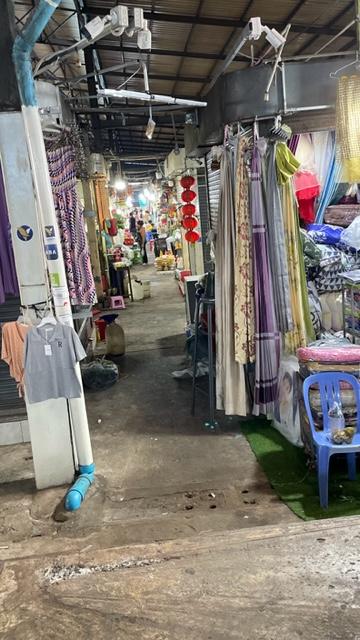Sihanoukville, Cambodia: Day 49
This was our first time into Cambodia and the ship was docked here only from 6 am to 4 pm. We were
assigned to the second departure for our tour, it didn’t leave until 12:45, so we made it good for us by
taking the free shuttle bus into town. Early. To see the market which had awakened--as all do—before
6 am. The disparity between rich and poor was glaringly evident in this huge market with glass cases of
god jewelry adjacent to a stall with a whirring old-time sewing machine making clothing.
assigned to the second departure for our tour, it didn’t leave until 12:45, so we made it good for us by
taking the free shuttle bus into town. Early. To see the market which had awakened--as all do—before
6 am. The disparity between rich and poor was glaringly evident in this huge market with glass cases of
god jewelry adjacent to a stall with a whirring old-time sewing machine making clothing.
Sihanoukville (see HA nook vil) is a harbor city built in 1955 by King Sihanouk who wanted a large
seaport. Currently, the city is planning to build a deeper port to allow bigger cruise ships to land in its
port. Our ship is smaller than many and can utilize more shallow ports.
seaport. Currently, the city is planning to build a deeper port to allow bigger cruise ships to land in its
port. Our ship is smaller than many and can utilize more shallow ports.
“Can you understand me?” our guide, Serey asked in his broken English, “You need to understand me
because we’ll be walking in the forest today.” We have had a wide range of English skills displayed by
guides on our various tours. Seray’s was in the middle echelon. The bus microphones don’t help and
thus we are often left with a disjointed set of information. 90% of Cambodians are Buddhist. Cambodia
is a democracy. It became one in 1991 and now has more than 10 political parties. It did not appear to
be as affluent as our recent stops in Vietnam. “Nobody could get here in the 1960s due to the jungle
and malaria,” he offered, then proclaimed the progress made in the past 50 years. Now it’s known for
its beaches.
We took a 30-minute ride into the countryside to Ream (two syllables) National Park, a rainforest/jungle of mangroves, water, melaleuca trees, ferns of many kinds. We enjoyed a quiet electric motored boat ride sighting some white jellyfish as we glided by “If you step on one, our kind will only make you itch. Just pee on it.” We didn’t see any sea urchins that are more lethal but people have begun including them in their diets, so are more scarce nor did we see the small shark that are in the waters and happily eaten every day. After a boat ride through a jungle channel, we hiked above the marshy ground on a wooden pathway to get to the Giant Tree which is 50 m tall and takes 17 people to encircle with arms connected. Our hike ended at an upper-scale camping experience in geodesics near the water.
“Yes, there are tigers in Cambodia, but not where humans are,” Surey said.
“Yes, there are tigers in Cambodia, but not where humans are,” Surey said.
Huh.
Next stop was Majestic Mountain, where there were more Buddhist icons, a temple, a school with
monks and novices (“Begin at age 7”), and an entire mountain space dedicated to prayer. We found it
ostentatious but perhaps we’re biased. We took too many photos because we stayed too long.
Lastly, we stopped at a large statue along the road that “all who get married have their photos taken
here.” Surey shared the folklore about this water god who loved a woman who took him underwater to
his “Dragon Planet” to marry and kept her alive by holding tight to her scarf. “100% of Cambodia people photograph this statue and we call it Love Statue.”
monks and novices (“Begin at age 7”), and an entire mountain space dedicated to prayer. We found it
ostentatious but perhaps we’re biased. We took too many photos because we stayed too long.
Lastly, we stopped at a large statue along the road that “all who get married have their photos taken
here.” Surey shared the folklore about this water god who loved a woman who took him underwater to
his “Dragon Planet” to marry and kept her alive by holding tight to her scarf. “100% of Cambodia people photograph this statue and we call it Love Statue.”
It’s always interesting to hear about a country from a native point of view. Their voices are always
proud and they welcome questions. I wonder. Would we?























Comments
Post a Comment